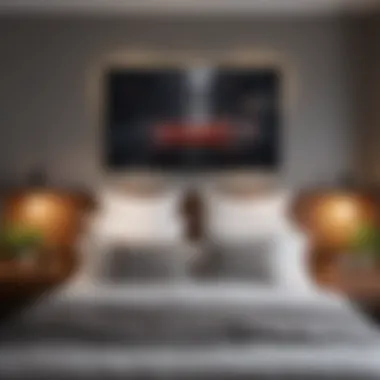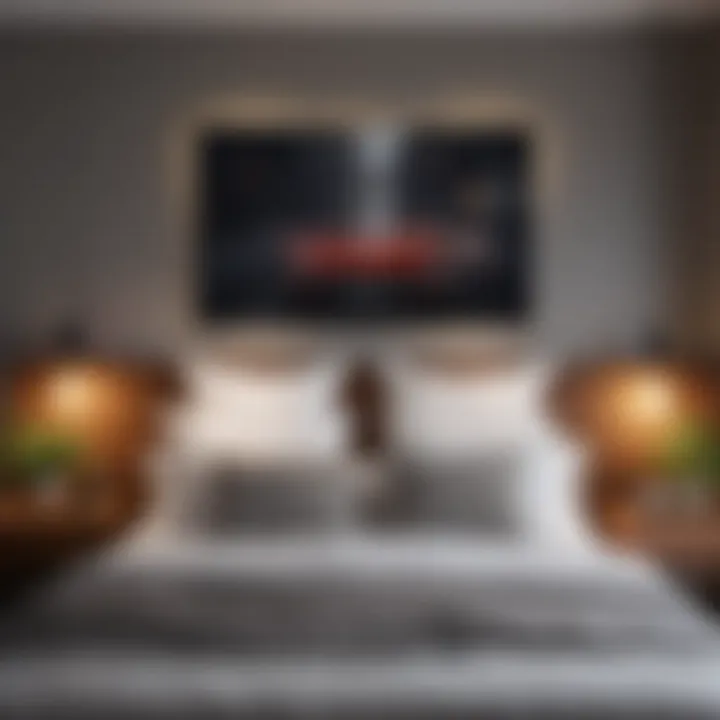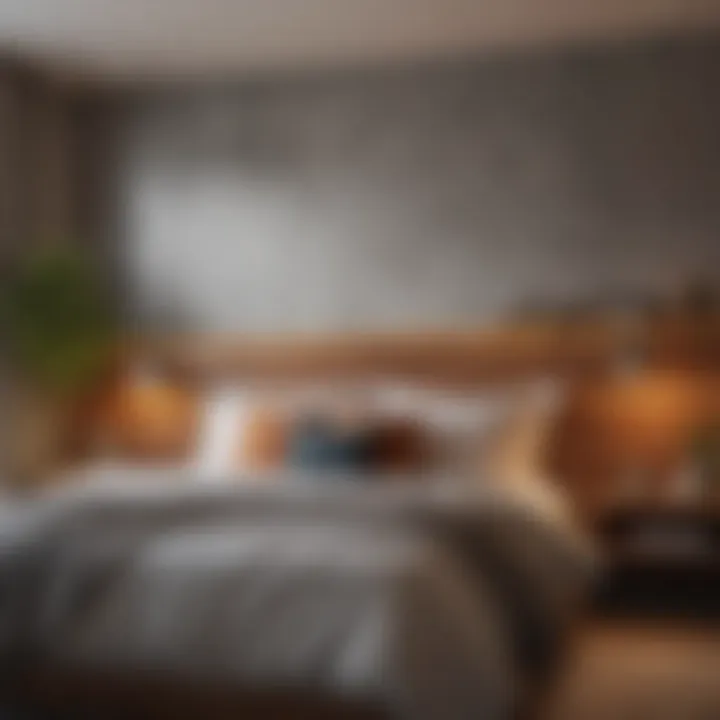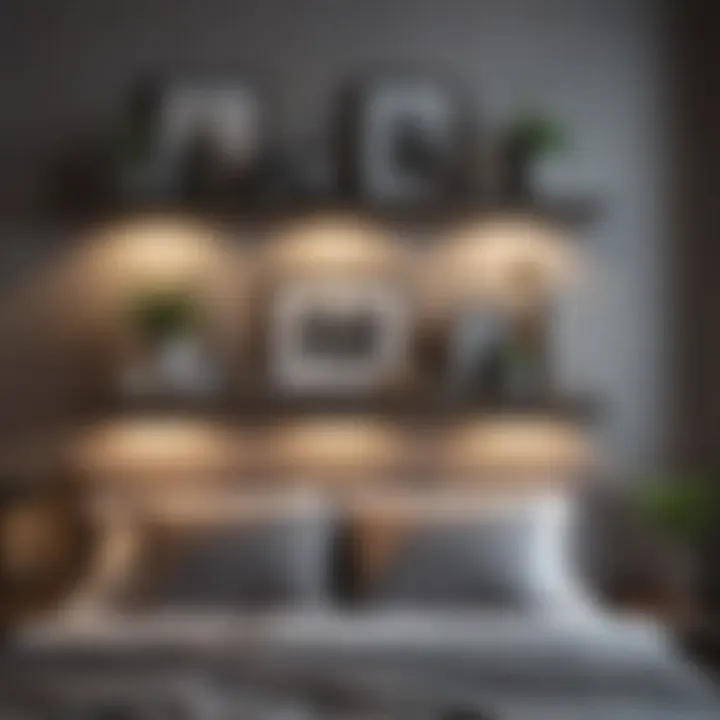Creative Ways to Decorate the Wall Behind Your Bed


Intro
Decorating the wall behind your bed plays a crucial role in enhancing the overall ambiance of your bedroom. It is not merely about aesthetics; this space significantly affects how you feel in your sleeping environment. A thoughtfully designed wall can provide comfort, inspire relaxation, or even make a bold statement. The key is to find a balance between personal preferences and practical functionality. This article will guide homeowners and renters alike through diverse approaches to transform this important area.
Design Inspiration
When considering how to approach the decoration of the wall behind your bed, it’s helpful to draw inspiration from current design trends and the effects of different color palettes. Understanding these aspects will enable you to craft a space that reflects your style and meets your needs.
Current Interior Design Trends
Interior design is constantly evolving, and it’s essential to stay updated on trends to create a space that feels current. Here are some contemporary styles that resonate well:
- Minimalist Designs: Focus on simplicity and clutter-free spaces. A single piece of artwork or a simple mural often suffices for impact.
- Eclectic Styles: Mix and match various design elements for a personalized look. Combining textures and colors allows for creative expression.
- Nature-Inspired Themes: Materials like wood and stone, along with plants, create a calm and refreshing atmosphere.
- Geometric Patterns: Incorporate shapes through wall decals or painted designs for visual interest without overwhelming the senses.
Each of these styles can help inform your choices, but it is essential to select what resonates most with your taste and lifestyle.
Color Palettes and Their Effects
The colors you choose for the wall behind your bed can greatly influence your mood and the overall feel of your bedroom. Here are some effective color strategies:
- Cool Colors: Blues and greens promote calmness and tranquility, making them ideal for a restful environment.
- Warm Colors: Reds, oranges, and yellows can energize the space, adding a cheerful and inviting feel, but should be used sparingly as accents.
- Neutral Tones: Whites, grays, and beiges provide a versatile backdrop that supports various design elements without competing for attention.
- Accent Walls: Consider painting one wall a bold color while keeping the rest neutral. This creates a focal point without overwhelming the room.
By choosing colors wisely, you can create a balance that complements your personal style while promoting relaxation.
"Your bedroom should be a sanctuary, reflecting who you are and offering comfort and peace."
Understanding the Importance of Wall Decor
Decorating the wall behind your bed is more than a mere aesthetic choice. It defines the space and sets the mood of the entire room. The possibilities are numerous. Wall decor can enhance your personal style while adding depth and character to your bedroom.
One must recognize how essential wall decor is in crafting a cohesive environment. It allows for personal expression and can either complement existing elements or serve as a stunning contrast. A well-decorated wall draws the eye and can create a sense of balance. Moreover, it has the potential to influence the perception of space. A bare wall can feel stark and uninviting. Conversely, a tastefully adorned wall fosters warmth and comfort. Such factors are crucial, particularly in the bedroom where relaxation is paramount.
The following sections will delve deeper into why wall decor matters, focusing on its role in bedroom aesthetics and how it can create a focal point.
Role in Bedroom Aesthetics
The choice of decor sets a distinct tone for the bedroom. Each piece placed on the wall contributes to the overall atmosphere. It's important to assess how colors, shapes, and materials influence aesthetics. For example, light colors promote a sense of serenity, while bold shades can energize a space.
Textures also play a significant role. A smooth canvas may convey a minimalist vibe, whereas something like a woven tapestry can add an element of coziness. Thus, the decor behind your bed should not be an afterthought; it should reflect the intended atmosphere and personality of the room.
Creating a Focus Point
Having a focus point on the wall behind your bed is essential. This area can act as a visual anchor that grounds the design of the room. A large piece of art or a unique wall of shelving draws attention and provides an opportunity to showcase personal interests and memories. It pulls the eye into the space, encouraging an appreciation of the surrounding decor.
Moreover, the focus point can also serve practical purposes. For example, incorporating lighting can enhance the aesthetic while providing functional illumination. When designing this focal area, consider how it interacts with other elements in the room. Balance is key. A thoughtfully selected statement piece can elevate the entire bedroom design and amplify the impact of your decor choices.
Assessing Your Bedroom Space
Assessing your bedroom space is critical to effective wall decor behind your bed. This phase sets the foundation for all design decisions. Understanding the physical environment helps to create a cohesive and functional aesthetic. Key elements such as wall dimensions, colors, and textures inform choices throughout the decorating process. These assessments ensure that all decor elements fit harmoniously within the environment.
Measuring Wall Dimensions
Measuring wall dimensions might seem straightforward, but it is an essential step in the decorating process. Start by using a tape measure to determine the height and width of the wall behind your bed. This information guides you in selecting suitable artwork, shelving, or other decorative elements.
Take note of these specific details:
- Height: Measure from the floor to the ceiling to gauge how much vertical space is available. Higher ceilings allow for larger pieces or layered decor, while lower ceilings may require more compact designs.
- Width: Measure the full width of the wall. Consider whether you want to cover the entire space or focus on a central feature.
Also, note any protrusions such as windows, built-in shelves, or light switches. These will affect the layout and design choices. Proper measurements will prevent costly mistakes later on, like purchasing a piece that is too large or too small for your space.
Identifying Existing Colors and Textures
The existing colors and textures in your bedroom play a vital role in shaping your decor style. Pay attention to the wall color, furnishings, bedding, and any other elements within the room.
- Color: Determine the current color palette. If your room has neutral tones, you may choose bold wall art to create a striking contrast. On the other hand, if your decor features vibrant colors, you may select more subdued elements for a balanced appearance.
- Textures: Look at various textures around you. For instance, soft bedding, rough wooden furniture, or glossy accessories can influence the material choices. Incorporating a mix of textures can add depth and interest to your wall decor.
Overall, this thorough examination of colors and textures ensures that your wall decor will complement the existing aesthetic.
In summary, measuring dimensions and understanding existing elements will lay the groundwork for successful wall decoration behind your bed.
"A well-thought-out environment reflects your personal style and enhances the overall appeal of the space."
By carefully assessing these key aspects, you set the stage for a beautifully decorated wall that elevates your sleeping space.
Choosing a Style: Modern, Classic, or Eclectic
Choosing a style for the wall behind your bed can significantly alter the overall appearance and feel of the bedroom. The choice of style affects not only aesthetic appeal but also how you feel in that space. Each style brings its unique elements and personality to the room. By carefully considering modern, classic, or eclectic styles, you can create a bedroom that reflects your personal taste while functioning well for your needs.
Modern Minimalism
Modern minimalism is characterized by clean lines, a neutral color palette, and an overall uncluttered feel. This approach provides a sense of tranquility, making it ideal for a bedroom space where relaxation is a priority. Key elements of modern minimalism include:
- Simple Shapes: Focus on geometric shapes in art and furniture, which enhances the feeling of open space.
- Neutral Colors: Use whites, greys, and blacks as the base, pairing them with subtle textures to avoid a stark feeling. Adding one or two accent colors can provide warmth without overwhelming the sense of calm.
- Functionality: Select decor that serves a purpose, such as a wall-mounted shelf that holds both decorative items and books.
- Less is More: Avoid overcrowding the wall with too many pieces. A few selected items can make a more significant impact than a multitude of objects.
The benefits of this style include making the room feel larger and more spacious, which is ideal for small bedrooms. It reduces distractions, thus promoting better sleep and relaxation.
Timeless Classic
Timeless classic design captures the essence of elegance and tradition. This style relies on symmetry, rich materials, and an attention to detail. It can instill a sense of history and comfort. Important features of classic style include:
- Symmetrical Arrangements: Position elements such as artwork and furniture in a way that creates visual balance.
- Rich Colors and Textures: Deep hues like navy, burgundy, and forest green paired with various textures in fabrics and finishes can evoke warmth and opulence.
- Traditional Artworks: Use of classic art pieces or landscape paintings can enhance the connection to art history.
- Ornate Frames and Details: Choosing decorative frames for artworks or mirrors can add to the classical feel.
Including timeless pieces in your decor not only offers enduring beauty but also assurance that your design will not quickly date or feel out of style. These decorations can create a welcoming atmosphere, encouraging the feeling of home.
Eclectic Combinations
The eclectic style encourages mixing elements from different styles and periods, creating a personalized and dynamic space. It reflects individual personalities and unique tastes. When going for an eclectic style, key points to keep in mind include:
- Diverse Influences: Incorporate various styles like vintage, modern, and boho, pulling from different eras.
- Vibrant Colors: Use bold colors and patterns; however, maintaining a cohesive theme can help tie the diverse pieces together.
- Variety of Textures: Mixing textures such as wood, metal, and fabric can add depth and interest.
- Personal Artifacts: Include personal mementos or travel finds to create a story behind your wall’s decor.


The benefit of the eclectic style is that it allows expressive freedom and flexibility. It provides a space that feels lived-in and truly reflective of one’s identity, making it inviting and warm.
Ultimately, the style you choose for the wall behind your bed has a lasting impact on the bedroom environment and influences your daily living experience.
Using Art as Wall Decor
Decorating the wall behind your bed is an essential part of making a bedroom feel inviting and personalized. Using art as wall decor adds character to the space and helps reflect your individual style. Wall art serves not just as decoration but also as a statement of your preferences and interests. It can create a sense of depth and warmth, making your sleeping environment more enjoyable.
Art pieces can act as focal points and conversation starters. The choice of art, its placement, and the way it interacts with other elements in the room can significantly influence the overall atmosphere. Furthermore, incorporating art can enhance the relaxing quality of your bedroom, especially when mindfully chosen and arranged.
Types of Wall Art
When exploring options for wall art, you can choose from a variety of styles and mediums. Here are some popular types:
- Paintings: Classic options that can range from abstract to realism.
- Photography: Personal photos or professional prints can bring a unique touch.
- Prints and Posters: Affordable and come in numerous styles and themes.
- Framed Artwork: Giving a polished look while adding dimension.
- Canvas: Offers texture and depth, enhancing visual interest.
- Wall Sculptures: Provide a three-dimensional aspect to the decor.
- Mixed Media: Combines various materials for unique pieces.
Each art type brings its distinct flair and can be used to develop the theme of your decor. Consider the mood you want to evoke when selecting the art type.
Arranging Art Pieces
The arrangement of art pieces is critical. A well-organized gallery can be both inviting and aesthetically pleasing. Follow these guidelines for effective arrangement:
- Balance: Ensure that the layout feels balanced. This can be achieved by varying the size and orientation of the art.
- Spacing: Maintain consistent spacing between pieces. The ideal distance often ranges between 2 to 5 inches depending on the size of the artworks.
- Height: A common mistake is hanging art too high. Aim to position the center of the artwork at eye level.
- Grouping: Group smaller pieces together. A unified collection adds character, while larger statement pieces can stand alone.
"Art is not what you see, but what you make others see."
— Edgar Degas
- Theme Cohesion: Use a common theme or color palette to ensure harmony among the pieces.
- Experimentation: Don't hesitate to try different arrangements with painter’s tape or by using paper templates to visualize placement before hanging.
By thoughtfully selecting and arranging wall art, you achieve not only a decorative quality but also an atmosphere aligned with your personality and taste.
Incorporating Shelving
In the realm of bedroom decor, shelving is often an underrated element. Integrating shelves behind the bed can significantly enhance the visual appeal and provide functional benefits. Not only does shelving offer storage solutions but it also presents opportunities for personalized decor. With the right choices, shelves can transform an ordinary wall into a stunning focal point.
The importance of incorporating shelving lies in its dual role. On one hand, it serves practical purposes such as holding books, plants, or decorative items. On the other hand, it can be styled in a way that complements the overall design of the room. When planning your bedroom decor, consider how shelving allows for creative expression and arrangement, which can add depth to your space.
Functional vs. Decorative Shelves
When deciding on shelves, it is essential to differentiate between functional and decorative shelves. Functional shelves are sturdy and designed to hold various items like books or even your nightly essentials. They offer a practical solution to maintain organization in the bedroom.
In contrast, decorative shelves focus more on aesthetics. They can hold lightweight decor items such as picture frames, small artworks, or trinkets that display your personality. Combining both types can yield a balanced look where functionality meets style. Think carefully about what you want the shelves to achieve before selecting materials and designs.
- Functional Shelves:
- Decorative Shelves:
- Made from strong materials like wood or metal.
- Ideal for heavier items.
- Often include features like brackets or supports.
- Made from lighter materials like glass or reclaimed wood.
- Showcase small decor items and art.
- Add beauty without carrying weight.
Ideas for Shelf Decoration
Once you've selected the type of shelves, you can begin to explore ideas for decoration. Shelves can become a canvas for creativity. Here are some practical ideas:
- Layering and Grouping: Arrange items in groups of varying heights. This adds interest and visual appeal.
- Incorporate Plants: Greenery brings life to any space. Use small potted plants to add a natural touch.
- Add Personal Elements: Display photographs or souvenirs from travels to give a unique and personal feel.
- Use Uniformity for Cohesion: Choose items in similar colors or styles for a cohesive look.
- Change with Seasons: Rotate your decorative items as the seasons change to keep the look fresh.
By thoughtfully incorporating shelving, you can create a wall that encapsulates both style and practicality, enhancing the overall atmosphere of your bedroom.
Exploring Textiles and Fabrics
Textiles and fabrics play a crucial role in the decorating process for the wall behind your bed. They offer a softer alternative to traditional wall art or paint. Incorporating textiles creates a warmer and more inviting atmosphere. Fabrics can serve multiple functions, including sound absorption and temperature regulation, making the bedroom more comfortable. This section will explore the value of fabric in wall decor, focusing on wall hangings and the materials to choose.
Wall Hangings as a Decor Option
Wall hangings have become a popular choice in interior design. They provide texture and warmth to a space. Fabrics like macramé, woven art, or even tapestry can transform a plain wall into a vibrant focal point. They are an effective way to add color without overwhelming the space. One can choose patterns that resonate with personal style or create a cohesive theme in the bedroom.
When selecting a wall hanging, consider the size and scale relative to the wall and bed. A large piece can serve as a statement item, while smaller pieces can be arranged creatively. Additionally, wall hangings allow for flexibility; they can be easily changed out depending on trends or personal preference.
"Textiles provide not only aesthetic value but also a chance to express individuality in design choices."
Choosing Appropriate Materials
The choice of materials is vital when decorating with textiles. Different fabrics offer unique qualities that can enhance the bedroom environment. Common options include cotton, linen, and velvet. Cotton is versatile and easy to clean. Linen gives a casual, airy feel, while velvet adds a luxurious touch.
Consider also the durability and maintenance of materials. Choosing machine-washable fabrics can save time and effort. This is particularly useful for items that may collect dust or oils from the skin over time, like wall hangings.
Here are some key factors to keep in mind when selecting materials:
- Comfort: The fabric should feel good to the touch and be suitable for a bedroom environment.
- Size and Weight: Heavier fabrics may require stronger mounting options, while lighter options are easier to install and change.
- Color Fastness: Ensure that the colors will not fade over time when exposed to sunlight, especially in rooms with large windows.
Lighting Considerations
The placement and type of lighting around the wall behind your bed can greatly affect the overall ambiance of your bedroom. It plays an essential role in how the decor elements work together. Additionally, proper lighting can create an inviting atmosphere, encouraging relaxation and comfort. Good lighting not only enhances aesthetic appeal but also ensures the functionality of the space. If one chooses appropriate lighting techniques, they can accentuate art pieces, textiles, and other decor elements effectively.
Ambient and Accent Lighting
Ambient lighting serves as the primary source of illumination. It provides general light, allowing the room to be functional and welcoming. Think of a warm glow that fills the space, setting the foundation for other lighting options. Ambient options can include ceiling-mounted fixtures, wall sconces, or even recessed lighting that can highlight the wall behind the bed. Using warm white tones can create a serene environment, perfect for winding down at the end of the day.
Accent lighting, on the other hand, is applied selectively to draw attention to specific areas. This may involve using table lamps or wall-mounted fixtures to highlight art or other decor. It also allowsthe owner to showcase personal interests or any thoughtful decor decisions made earlier. When choosing accent lights, consider dimmable options. This flexibility encourages tailoring the lighting intensity according to different moods or activities.
Placement of Light Fixtures
Placement of light fixtures requires careful thought to optimize the function and aesthetics of the space. Start by assessing the existing dimensions and layout. Assess where the light will be positioned. Fixtures placed directly above the bed can provide direct illumination for reading or other activities. Bedside lamps are great choices for personal use, allowing individuals to manage their light sources easily.
Wall sconces can also be situated on either side of the bed. They serve as effective ambient lights and can be decorative elements that compliment the surrounding decor. Make sure the placement facilitates easy access, avoiding clutter on the bedside. Remember that lighting should not create glare or harsh shadows, thus improving the overall visual comfort.
In addition, consider the height of the fixtures. A common guideline is to position light switches and wall-mounted fixtures at a height of approximately 56 to 66 inches from the floor. This creates a harmonious flow throughout the space. Moreover, look for ways to integrate smart lighting solutions, which help enhance both functionality and energy efficiency.
Proper lighting can transform your bedroom's atmosphere, making it inviting and restful.
In summary, carefully choosing and placing ambient and accent lighting helps achieve a well-integrated design. Good light placement not only facilitates functionality but also adds depth and sophistication to the decor.


Adding Mirrors for Depth
In interior design, mirrors are more than just functional components; they serve as significant decorative elements, particularly in the context of wall decor behind a bed. Their reflective surfaces can create an illusion of space, enhancing the perception of the room's size and depth. This is crucial when aiming for a serene and spacious atmosphere, especially in smaller bedrooms. The right placement and style of mirrors can bring light into the room, making it feel more open and welcoming.
Moreover, mirrors can serve as focal points, drawing attention when one enters the room. They can complement other decor elements, providing balance and harmony to the overall design. Their ability to reflect colors and patterns also permits coordination with existing decor.
Types of Mirrors to Consider
When selecting mirrors for your bedroom wall, consider the following types:
- Framed Mirrors: These add elegance and can be matches to other furniture pieces. A bold frame can also add an artistic touch.
- Wall-Mounted Mirrors: These are versatile as they can be positioned at various heights and alignments, according to your preference.
- Full-Length Mirrors: Ideal for smaller rooms, they not only aid in aesthetic but also in functionality by allowing you to view your outfit from head to toe.
- Artistic Mirrors: Featuring unique designs and shapes, these can enhance the artistic flair of the bedroom while serving as conversation starters.
Opting for the correct type will depend on your overall design vision, the available space, and your personal style.
Strategic Placement of Mirrors
When placing mirrors, think about the following strategies to maximize their effectiveness:
- Opposite Windows: Positioning a mirror directly across from a window can amplify natural light, illuminating the room during daytime. This can create a fresh and vibrant ambiance.
- Above Bed: Hanging a mirror above the headboard adds height and drama to the space. Choose a design that resonates with your overall decor to avoid disjointedness.
- Reflective Walls: Consider placing smaller mirrors in a group or pattern to form a gallery wall effect. This can visually expand the space and provide multiple focal points.
- Avoid Direct Reflections: Be mindful of what the mirror reflects. Positioning a mirror in a way that reflects clutter or unappealing views can detract from the room's serenity.
Accessing Sustainable Materials
In today’s world, the significance of sustainability extends into home decor. When you think about decorating, it is valuable to consider the environmental impact of the materials you choose. This section explores why it is essential to access sustainable materials for your wall decor. Doing so not only reduces environmental harm but also creates a healthier living space.
Choosing Eco-Friendly Decor Products
Selecting eco-friendly decor involves focusing on materials that are either renewable, recyclable, or non-toxic. Common options include bamboo, reclaimed wood, or organic cotton. These materials are less harmful to the environment compared to traditional ones.
When you select decor products, look for those labeled as sustainable or responsibly sourced. This ensures that the materials come from ethical sources that do not contribute to mass deforestation or pollution. Consider buying products from local craftsmen who prioritize sustainable practices. This supports local economies and reduces carbon footprints associated with transportation.
Benefits of Using Eco-Friendly Decor:
- Reduces waste in landfills
- Lowers carbon emissions
- Promotes healthier indoor air quality
- Supports ethical labor practices
Promoting Sustainability in Design
Promoting sustainability in design involves more than just choosing materials. It also means thinking about the lifecycle of your decor items. Consider how they will be made, used, and eventually disposed of. Emphasizing durability can help ensure that your decor lasts longer, minimizing the need for replacements.
Integrate recycled materials into your design. Products made from recycled content can be both beautiful and functional. For example, decorative pieces made from recycled glass or metal not only look stylish but also serve as conversation starters.
"Sustainable design seeks to minimize negative environmental impacts and promote a healthy and livable environment for all."
In addition, you might consider the following strategies:
- Utilizing multifunctional furniture: This can reduce the need for numerous items.
- Opting for timeless designs: Avoid trends that quickly go out of style, contributing to waste.
- Incorporating plants: They enhance air quality and add a natural element to your space.
By integrating sustainability into your decor choices, you create a space that reflects your values and contributes positively to the planet.
Implementing Personal Touches
In the realm of bedroom decor, personal touches serve as the heartbeat of a space. These elements transform a generic area into a sanctuary that reflects individual personalities, interests, and family history. This section highlights key benefits of personalizing your space and considerations to keep in mind when implementing these unique features.
By infusing your personality into your wall decor, you create an intrinsic connection with your surroundings. Each artwork, photograph, or handcrafted piece can tell a story, fostering a sense of belonging. This individualized decor can also inspire comfort and joy, crucial for a restful environment.
When selecting items for your wall, choose those that resonate with you. Family portraits might evoke nostalgia while travel souvenirs could remind you of adventures. These pieces not only enhance aesthetics but also enrich the atmosphere.
Showcasing Personal Interests
Showcasing personal interests on the wall behind your bed can bring vibrancy and life into your space. When selecting decor, consider hobbies and passions that define you. For a music lover, framed album covers or a vintage record player might suit the space well. Art enthusiasts could hang prints or original works that align with their taste.
Incorporating personal interests promotes authenticity. Each piece adds to the narrative of who you are. You might display a collection of books, art pieces, or any memorabilia that holds significance. The key is to present these items in a harmonious way that complements the overall design of your bedroom.
Here are some ideas to implement:
- Framed Art: Choose pieces that reflect your artistic taste.
- Personal Collections: Display objects from your travels or collectibles.
- Book Displays: Create a small shelf for your favorite books to highlight your literary interests.
Customizing with Family Memories
Customizing the wall with family memories creates a warm, inviting atmosphere. Personal photographs can work wonders when displayed thoughtfully. A gallery wall featuring snapshots from special moments—birthdays, vacations, or candid family shots—can evoke joy and connection.
When arranging these images, consider symmetry and layout. A cohesive frame style can help to unify the collection. Alternatively, mixing different styles can create an eclectic yet personal feel.
A few ways to customize the wall include:
- Photo Collages: Arrange photos in a creative layout, perhaps in the shape of a heart or tree.
- Shadow Boxes: Incorporate family keepsakes such as letters or trophies in shadow boxes.
- Memory Boards: Use corkboards or magnetic boards to display rotating memories or notes from family members.
The Impact of Color Psychology
Color has a profound effect on our emotions and behaviors. It influences how we perceive spaces and can alter our mood. When it comes to decorating the wall behind your bed, understanding color psychology is essential. The colors you choose can promote relaxation, encourage sleep, and create a harmonious environment. It is more than just aesthetics; it is about setting a mood that aligns with your personal space.
Understanding Color Theory
Color theory encompasses the basic principles of color interactions and how they combine to create different effects. The color wheel is a visual representation used to illustrate these relationships. It divides colors into primary, secondary, and tertiary categories. Understanding these categories can help in selecting colors that complement each other and enhance the overall design.
- Primary Colors: Red, blue, and yellow. These colors form the foundation.
- Secondary Colors: Green, orange, and purple, created by mixing primary colors.
- Tertiary Colors: Created by mixing primary with secondary colors. Examples are red-orange and blue-green.
Additionally, colors can be classified as warm (reds, oranges) or cool (blues, greens), helping to create different atmospheres in a room. Warmer colors might stimulate energy while cooler colors tend to create a calm and serene space—especially important for a bedroom.
Choosing Colors that Promote Relaxation
When it comes to creating a restful space, color choice is key. Soft hues tend to work better in promoting relaxation:
- Blue: Often associated with calmness, blue can help lower heart rates and promote tranquility.
- Green: This color reflects nature and brings a sense of peace and balance into a room.
- Lavender: Has soothing properties and can create a serene atmosphere.
- Greys: A neutral color that can evoke a sense of calm when used in lighter shades.
It is advisable to avoid overly bright or bold colors in the bedroom as they can stimulate energy rather than promote calmness.
"The right color scheme can significantly improve your sleep quality, comfort, and overall well-being in your sleep environment."
Maintenance and Upkeep of Decor Items


The maintenance and upkeep of decor items is often overlooked, yet it plays a crucial role in the lasting impact and appearance of your bedroom's aesthetic. Each piece on the wall behind your bed requires attention to detail. This includes cleaning, repairing, and sometimes even replacing items as they wear out. The overall ambiance of your space depends not just on the initial decoration but also on how you care for these elements over time.
Regular maintenance ensures that the decor remains visually appealing and serves its intended purpose. Decor items can accumulate dust and dirt, which can detract from their beauty and longevity. Keeping them in pristine condition enhances the mood of the bedroom. Additionally, regularly checking these items can help you catch any damages or wear early before they become bigger issues. This practice prolongs the life of the decor, thus saving money in the long run.
Cleaning Techniques for Art and Fabrics
Cleaning techniques for art and fabrics vary significantly depending on the material. For wall art such as paintings and prints, a simple soft cloth can help remove dust without damaging the surface. If you have framed art, ensure the glass is cleaned with a glass cleaner or a vinegar-water solution to avoid streaks. When cleaning fabrics, such as wall hangings or tapestries, check the care label first. Some fabrics can be gently vacuumed while others may require spot cleaning. Avoid using harsh chemicals, as they can fade or damage colors.
Consider the benefits of regular dusting:
- Preserves Color and Finish: Keeping art and textiles clean helps maintain their original look and feel.
- Allergen Reduction: Regular cleaning can reduce dust and allergens.
- Enhanced Longevity: Proper care can extend the life of your decor pieces.
Repairing Damaged Items
Damage to decor items, even if minor, can detract from their overall impact. Knowing how to repair these items can be invaluable. For paintings, minor scratches can often be touched up with paint that matches the original color. If a frame is damaged, you may need to re-glue or even replace sections for structural integrity.
For textiles that develop small tears, using a needle and thread can be an effective remedy. If the damage is significant, you might consider consulting a professional for restoration. Creating a checklist can help:
- Assess damage regularly: Identify what needs repairs.
- Gather necessary tools: Such as glue, paint, thread, or a sewing machine.
- Prioritize repairs based on significance: Tackle the most visible or impactful pieces first.
"Maintaining decor items is essential not just to preserve their beauty but also to enhance the comfort of your space."
Common Mistakes to Avoid
Decorating the wall behind your bed can enhance your bedroom’s overall ambiance and functionality. However, one must be cautious of certain common errors that can diminish this impact. Recognizing these mistakes and their implications can lead to more informed decisions. This section will explore two notable pitfalls: underestimating scale and proportion, and neglecting cohesion with the overall room design. By addressing these, you can create a more harmonious and visually appealing sleeping space.
Underestimating Scale and Proportion
When selecting decor for the wall behind your bed, scale and proportion are critical factors. Mistaking the size of artwork or decor items can result in a visual imbalance. For instance, a tiny piece of art on a large wall may appear lost, while oversized pieces can dominate the small space, creating discomfort.
- Measure Before Choosing: Ensure that you have the correct measurements for the wall space. This will help in selecting correctly sized artwork or shelves.
- Consider Bed Size: The size of the bed also plays a role. A king-sized bed requires a different scale of decor than a single bed. A larger art piece or multiple smaller pieces can work effectively above a larger bed.
A general guideline is to fill about two-thirds to three-quarters of the space above the headboard with art. This creates a focal point without overwhelming the space. Always visualize how the decor interacts with the elements around it, including furniture and room color.
Neglecting Cohesion with Room Design
Another common oversight is failing to maintain cohesion with the overall design of the bedroom. Each decor element should communicate harmoniously with other components, like furniture, colors, and textiles. A mismatch can lead to a jarring effect, detracting from the room's intended vibe.
- Color Schemes: Choose decor that complements the room’s color palette. If your bedding has specific color tones, incorporate those into the decor to provide visual continuity.
- Style Alignment: Ensure that the decor style aligns with the overall aesthetic of the room. A modern bed frame may appear out of place with vintage art unless thoughtfully styled.
Cohesion helps create a seamless flow and enhances your bedroom retreat.
"Attention to detail in scale, proportion, and cohesion creates a lasting impression and elevates your space."
Budgeting for Wall Decor Projects
Budgeting is a fundamental aspect of decorating the wall behind your bed. It sets the tone for your project and helps define what is achievable within your financial limits. Study shows that without a clear budget, one can easily overspend, leading to feelings of regret and dissatisfaction. Hence, understanding how to allocate your resources effectively can result in a more satisfying decor experience.
Effective budgeting involves several components. Firstly, it establishes clear priorities for your decor projects. Knowing what to invest in—be it art pieces, lighting, or shelving—will help you make informed decisions. By thinking in advance about which elements matter most to you, you can focus on those that enhance your bedroom aesthetics.
Furthermore, having a budget facilitates the search for cost-effective solutions. This ensures that the journey toward a beautifully decorated wall does not become a financial burden. It enables you to plan your purchases strategically, aiming for quality while considering price.
Finding Cost-Effective Solutions
Finding cost-effective solutions for wall decor can significantly impact your overall budget. Many assume that decorating must be expensive, but this is simply not the case. There are numerous ways to achieve stylish results without spending a large amount.
Thrift Shopping
Thrift stores and second-hand shops often carry unique pieces. You might uncover one-of-a-kind treasures that can serve as the focal point of your design. The allure of such items often lies in their character and history, which can add charm to your space.
DIY Projects
Consider crafting your own decor. Creating custom pieces allows for personalization while saving money. Simple projects such as painting canvases or refurbishing old frames can have a significant impact on the wall behind your bed. Relevant online resources can guide you through various DIY endeavors.
Seasonal Sales
Timing your purchases around sales events can also yield savings. Many retailers offer substantial discounts during holidays or specific sale days. Keeping an eye out for these opportunities allows you to buy quality items at lower prices.
Allocating Funds for Different Elements
Allocating funds smartly across various decor elements ensures a balanced and cohesive look. Not every item needs to be expensive or extravagant.
Prioritize Key Features
Identify what elements will be the focus of your decor. For some, a large piece of art could be that centerpiece. For others, it may be the lighting fixtures or a bold textile. Allocate more resources to these key features while paring down lesser priorities.
Spread Out Costs
Decorating can happen over time rather than all at once. One strategy is to allocate smaller amounts each month, allowing you to spread costs evenly. This method alleviates financial strain while still allowing for a beautiful transformation as you slowly curate your wall decor.
Be Flexible
Flexibility in your budget is also a wise approach. Prices vary, and finding alternatives becomes crucial. If you locate a captivating piece that exceeds your budget, look for similar options that can provide similar impact without the hefty price tag.
"A well-planned budget can transform your wall into a statement that reflects your style without breaking the bank."
Ultimately, effective budgeting for wall decor is about strategic planning, patience, and smart shopping. With a thoughtful approach, you can create an inviting space that satisfies without leading you into financial difficulties.
Culmination: Personalizing Your Space
Personalizing the space behind your bed is a pivotal element of interior design that significantly enhances the ambiance of your bedroom. This article has delved into the practical strategies for wall decoration, emphasizing the vital role personal expression plays in this process. By focusing on individual style, you create an environment that resonates with your personality, leading to a more comforting and appealing bedroom. This personalization not only reflects who you are but also instills a sense of pride in your living space.
Reflecting Individual Style
Every individual has unique tastes and preferences, which need to be evident in their surroundings. Reflecting your style behind the bed can involve various elements such as color, art, and decor types.
- Color Choices: The colors you choose act as a canvas for expression. Whether you prefer calm neutrals or vibrant hues, the color palette sets the tone for the entire room. Selecting a color that resonates with your emotions can elevate the space.
- Art Selection: Independently curated art pieces are excellent ways to showcase your interests. These can include paintings, photographs, or even wall sculptures. You should pick artwork that truly represents you and makes a statement.
- Decor Elements: Incorporate decor items that hold significant meaning. Items such as family heirlooms, travel souvenirs, or personal projects can make the wall a reflection of your experiences and values.
Creating an Inviting Atmosphere
Beyond aesthetics, creating an inviting atmosphere is crucial in a bedroom sanctuary. The wall behind your bed can influence how welcoming and cozy the space feels.
- Layering Textures: Consider using a combination of textures to provide depth. Textiles like fabric wall hangings or wooden plaques can make the space feel warm and inviting.
- Proper Lighting: Use lighting strategically to enhance the atmosphere. Soft, ambient lighting can add warmth, while accent lights can highlight specific decor items. The kind of light fixture can also contribute to the overall theme and comfort level of your room.
- Symmetry and Balance: Arranging decor in a balanced way can evoke harmony. A symmetrically designed wall behind your bed can result in a peaceful ambiance, which is essential for relaxation.
In summary, the conclusion underscores that personalization is not just about decoration; it is about creating a living space that feels right for you. By reflecting individual style and fostering an inviting atmosphere, the wall behind your bed becomes not only a focal point but a representation of who you are. As you embark on this journey of decorating, keep in mind the benefits of thoughtful design choices that enhance both function and aesthetic appeal.















